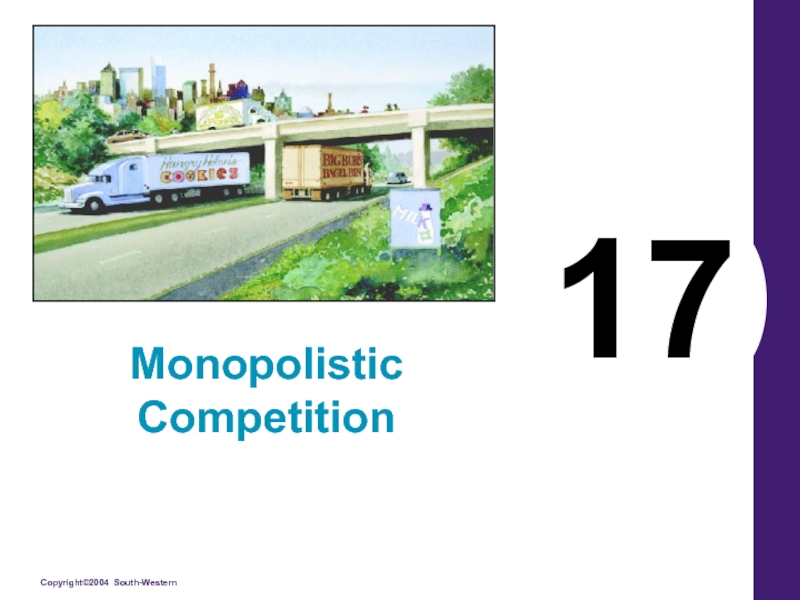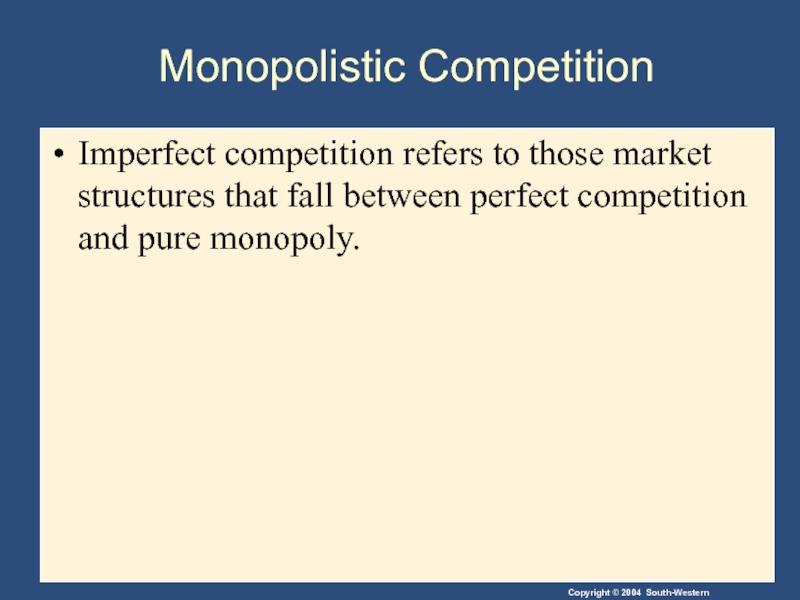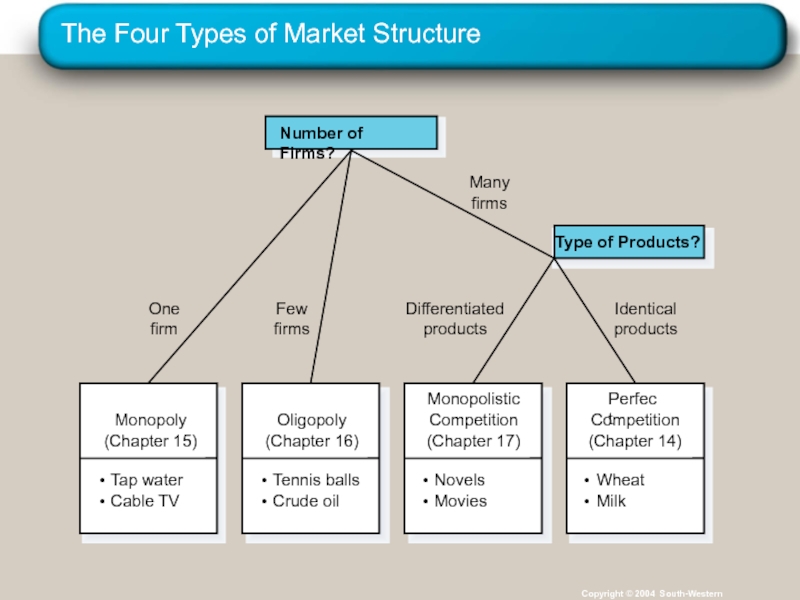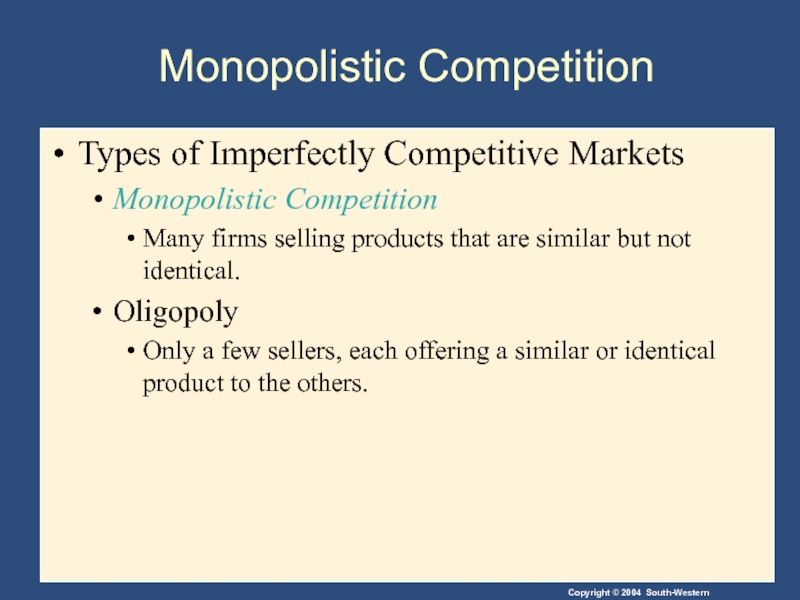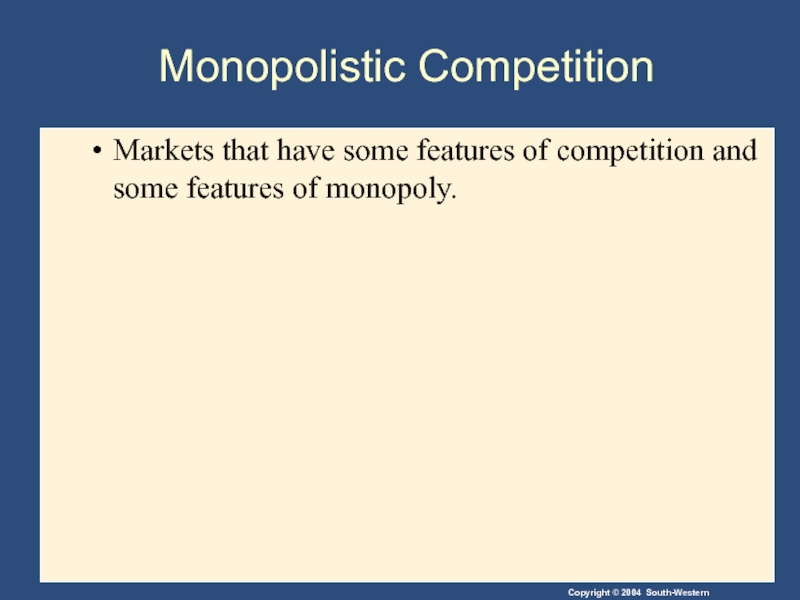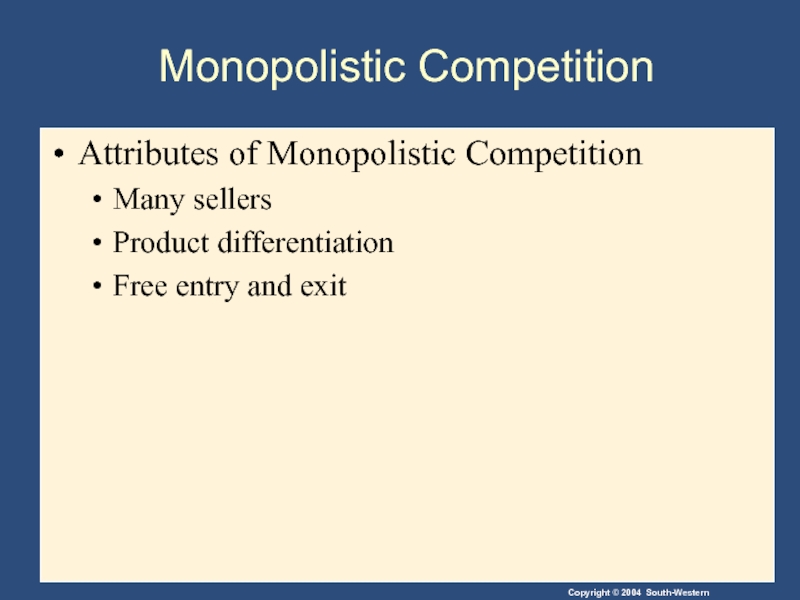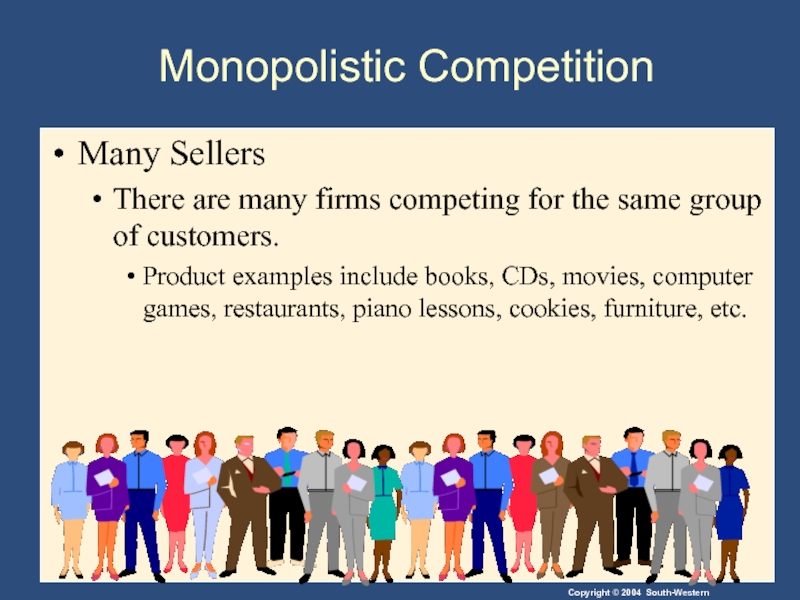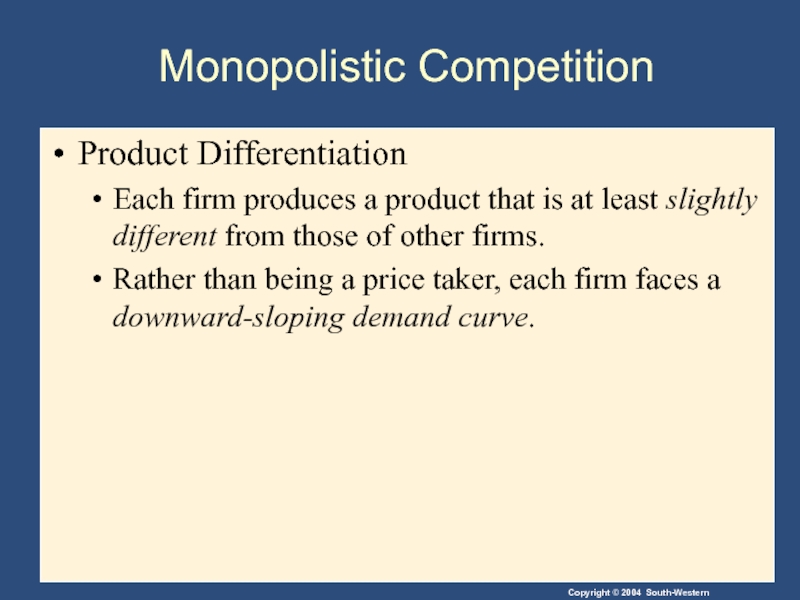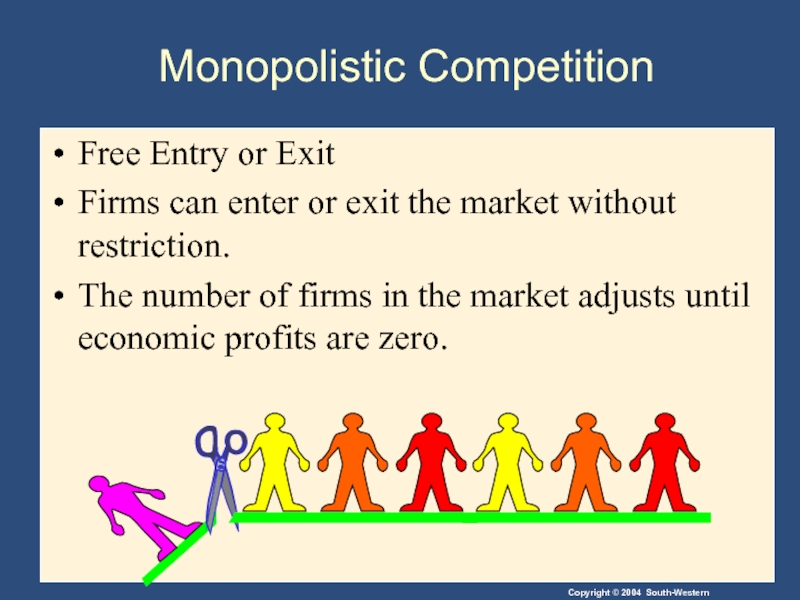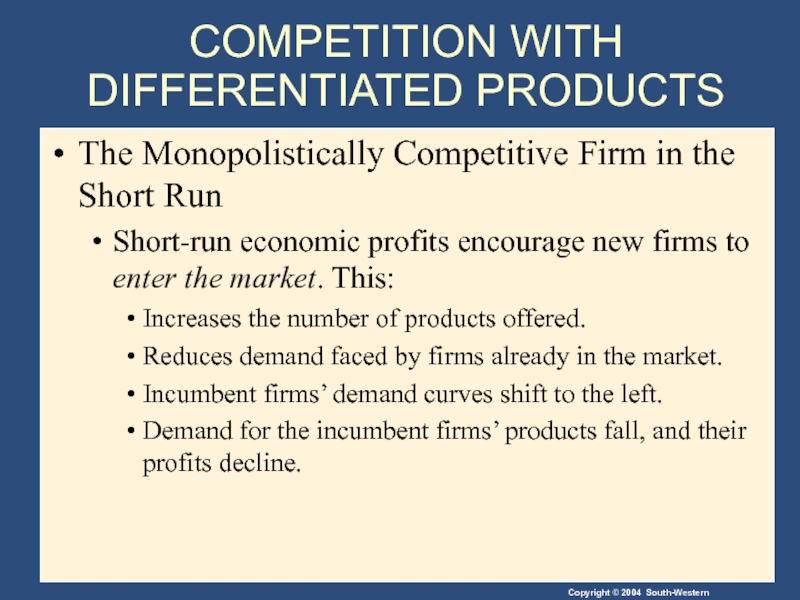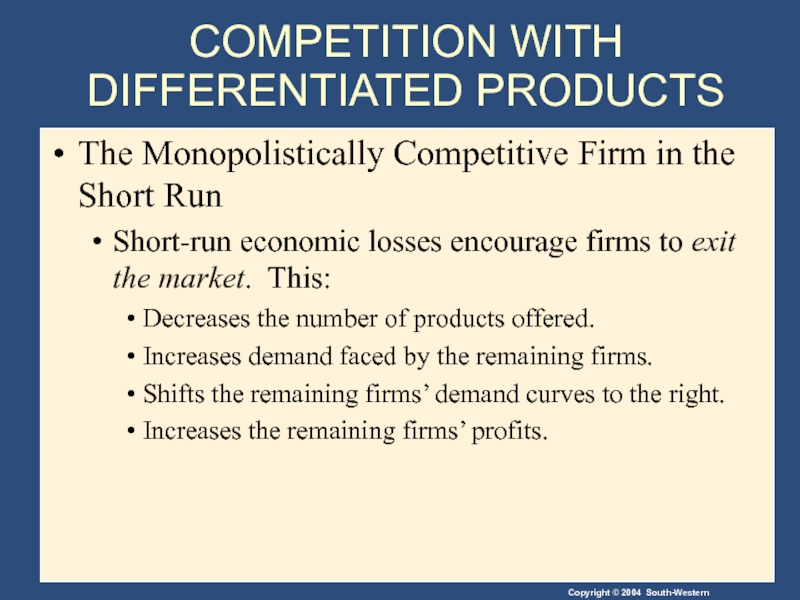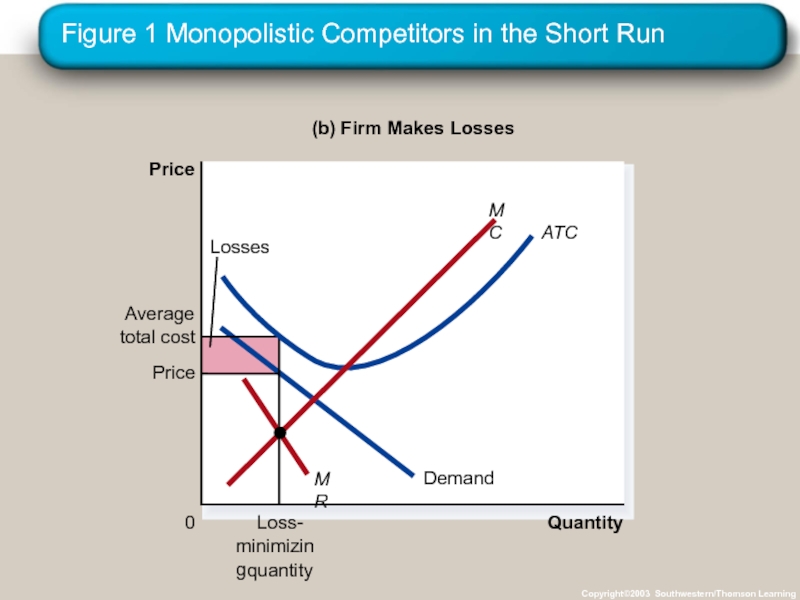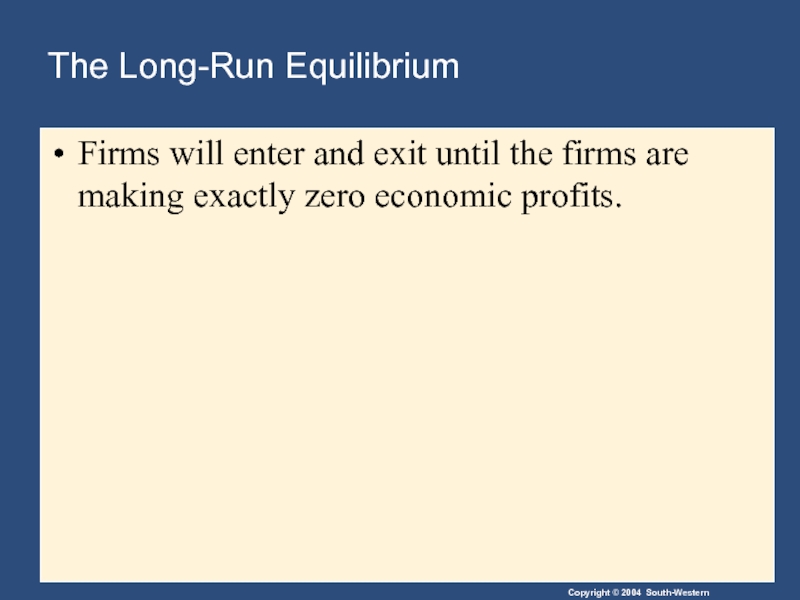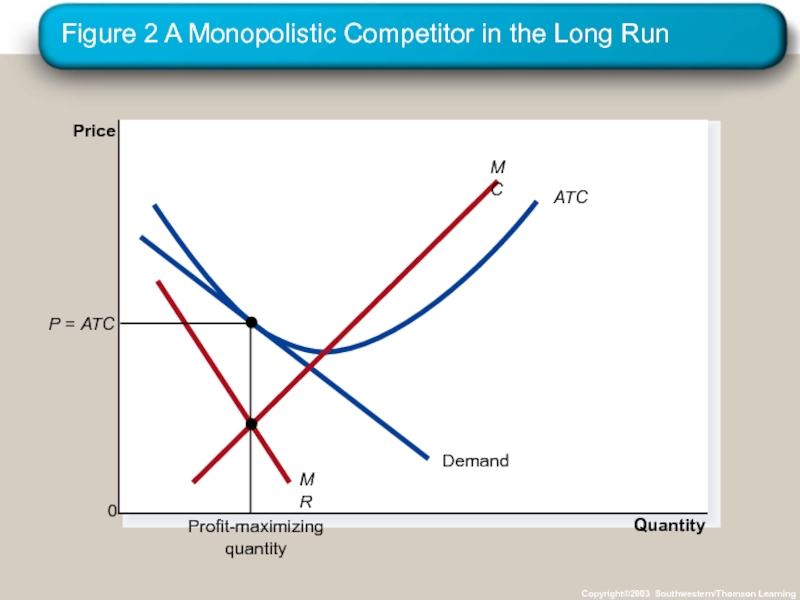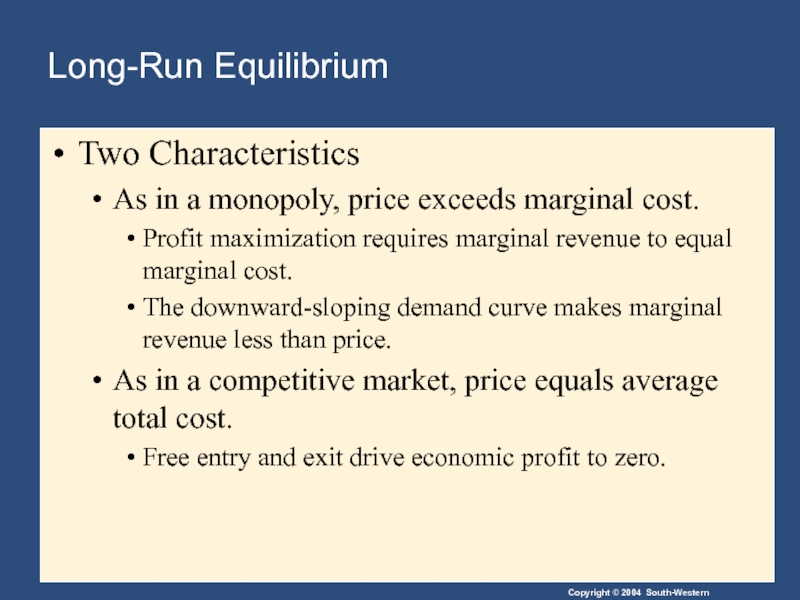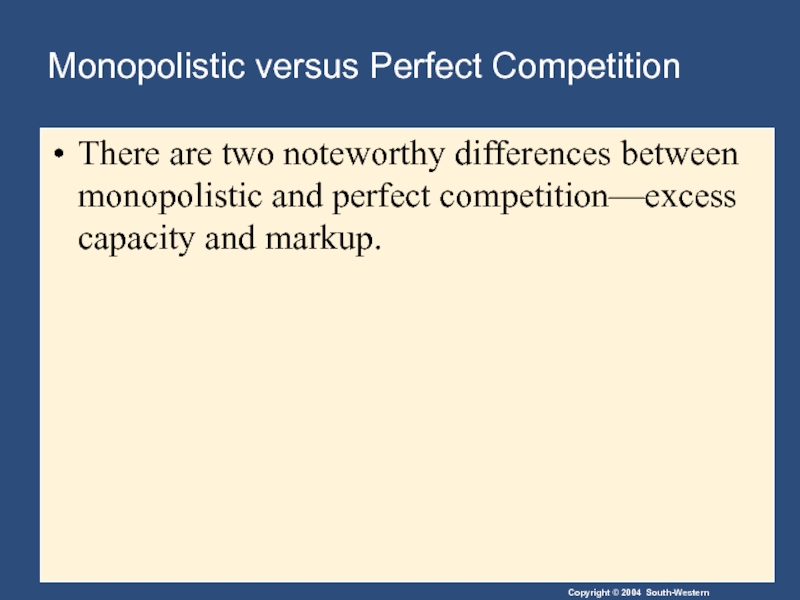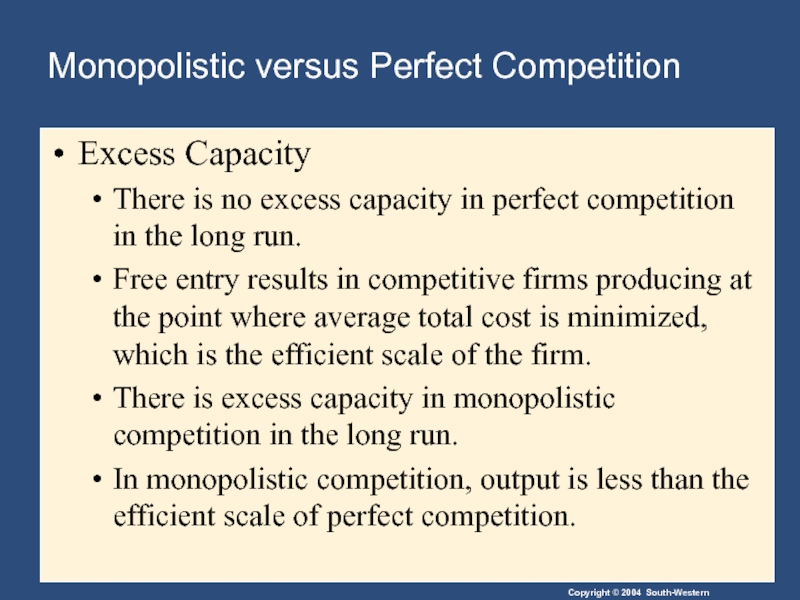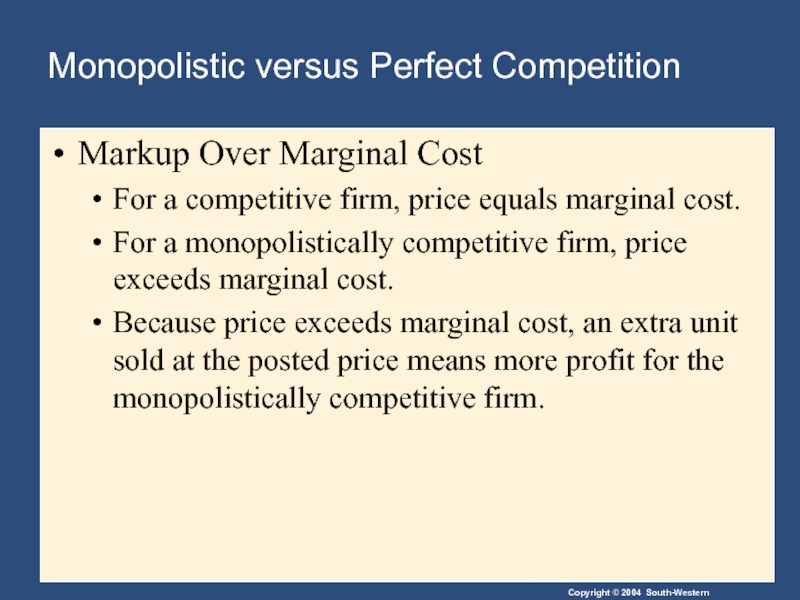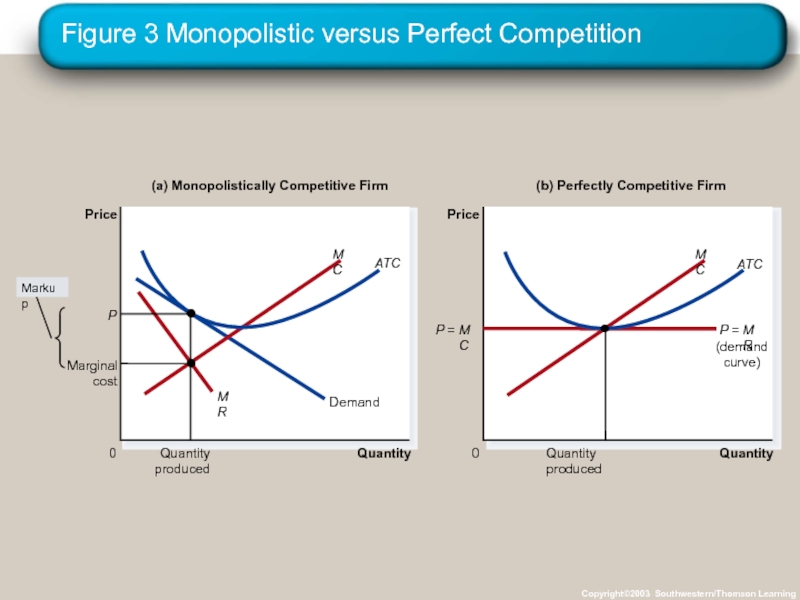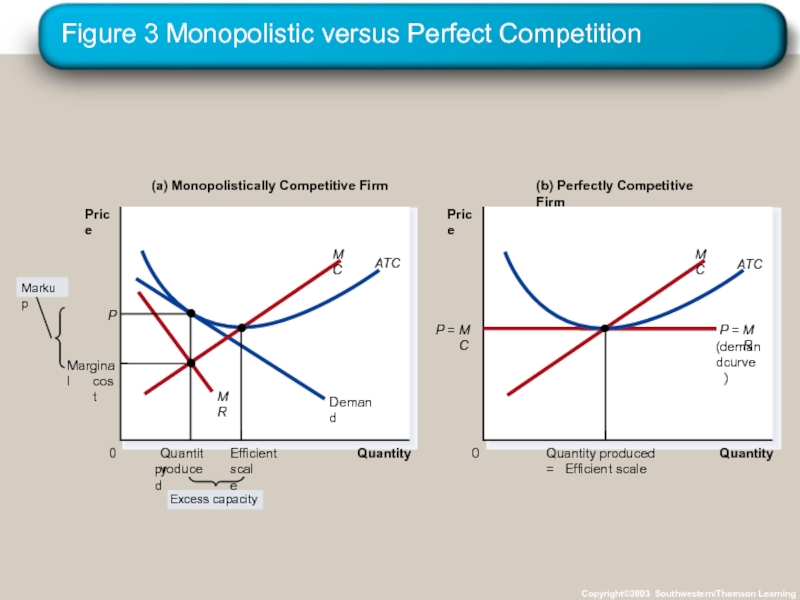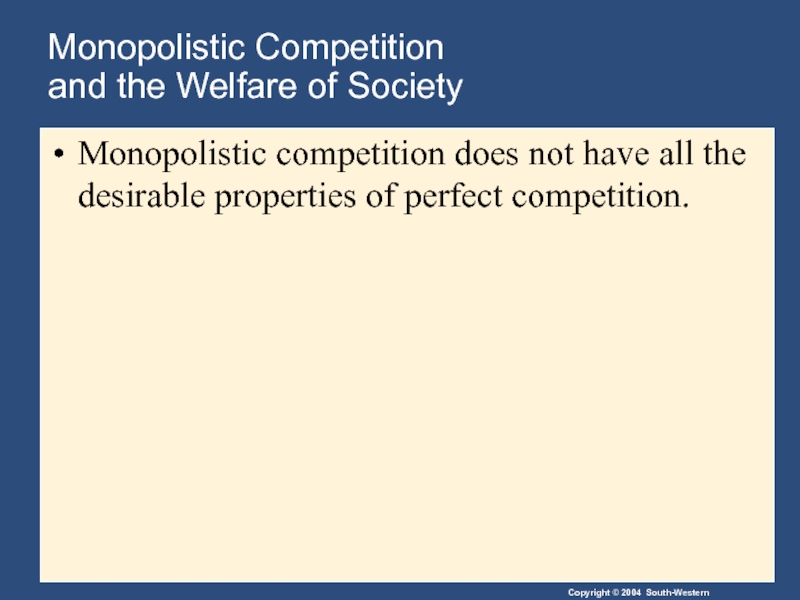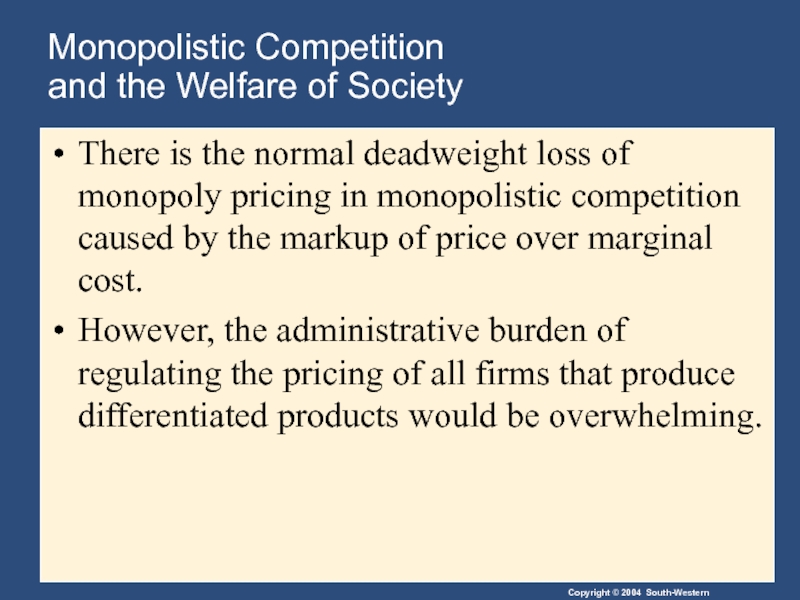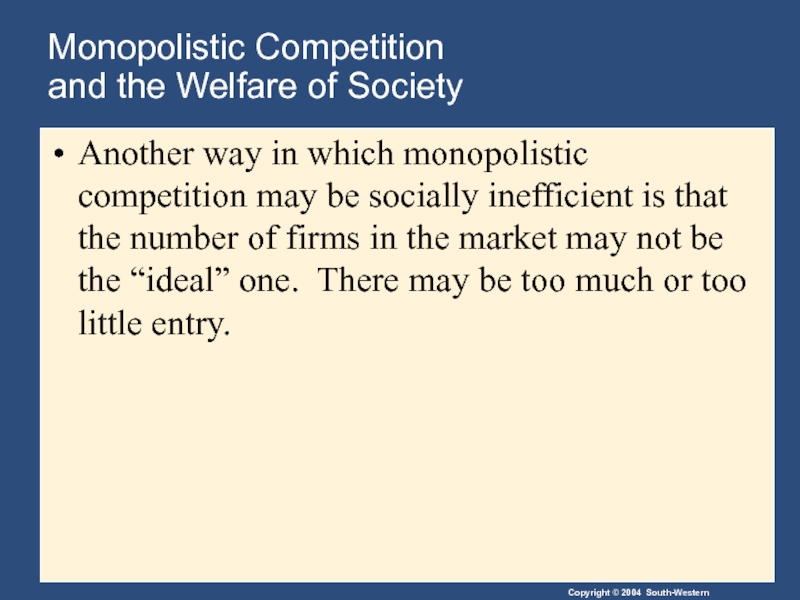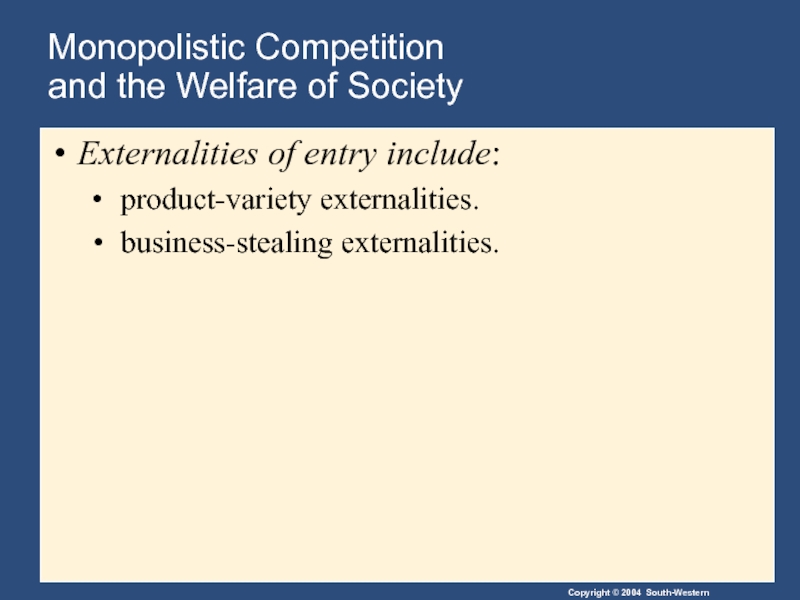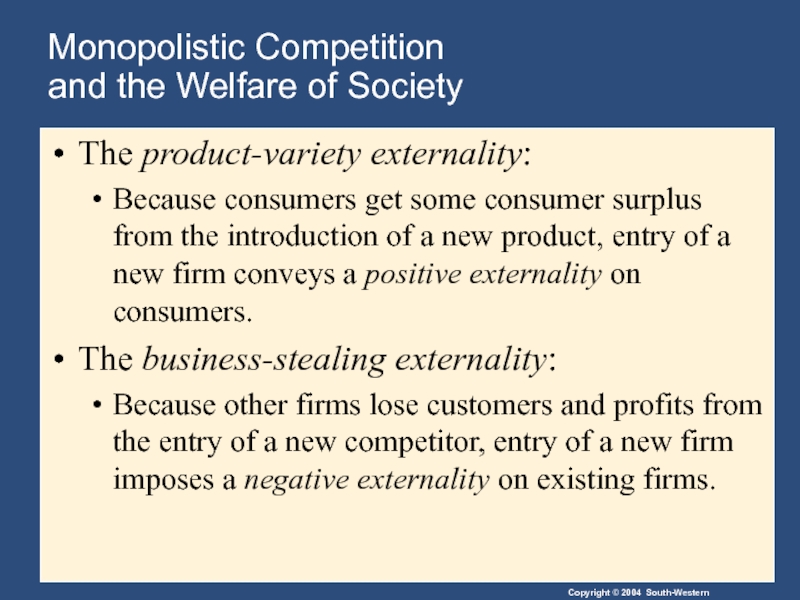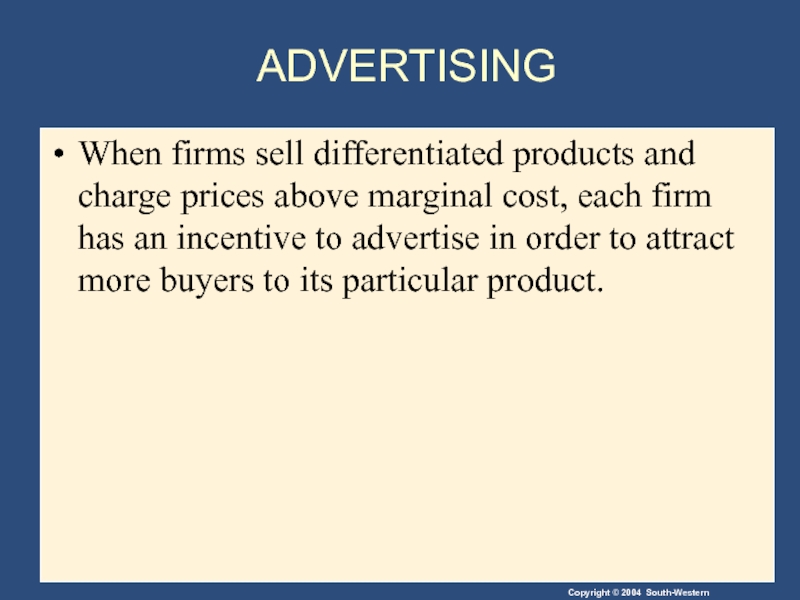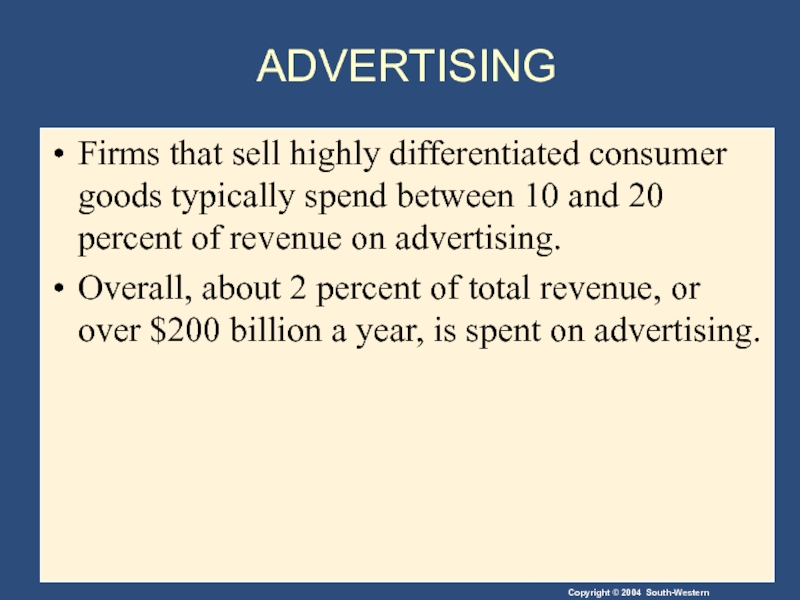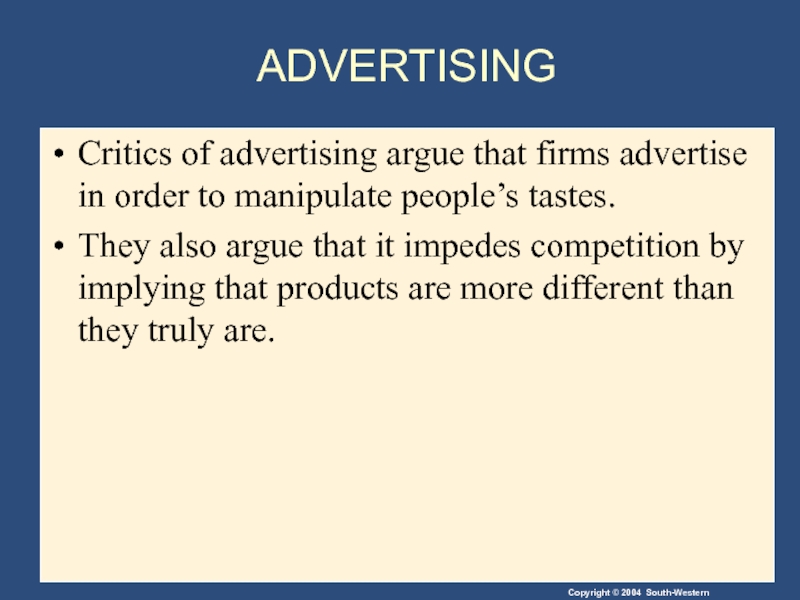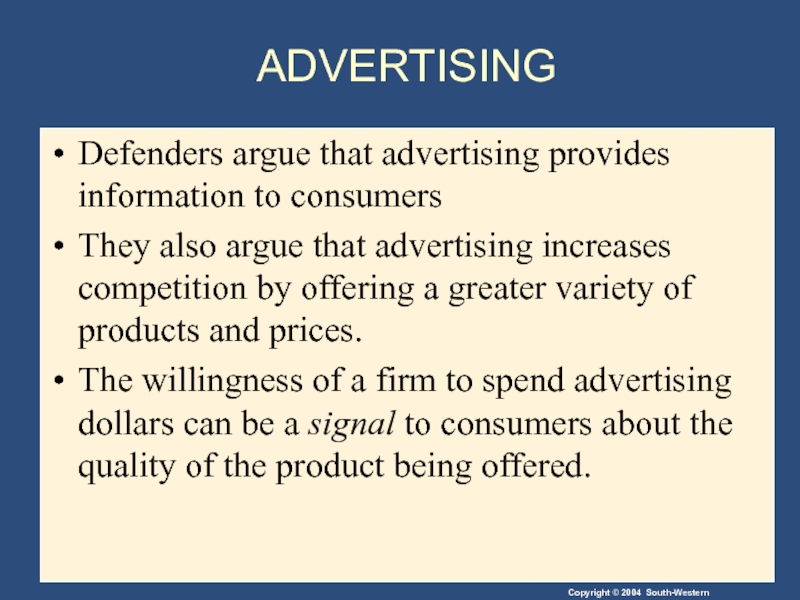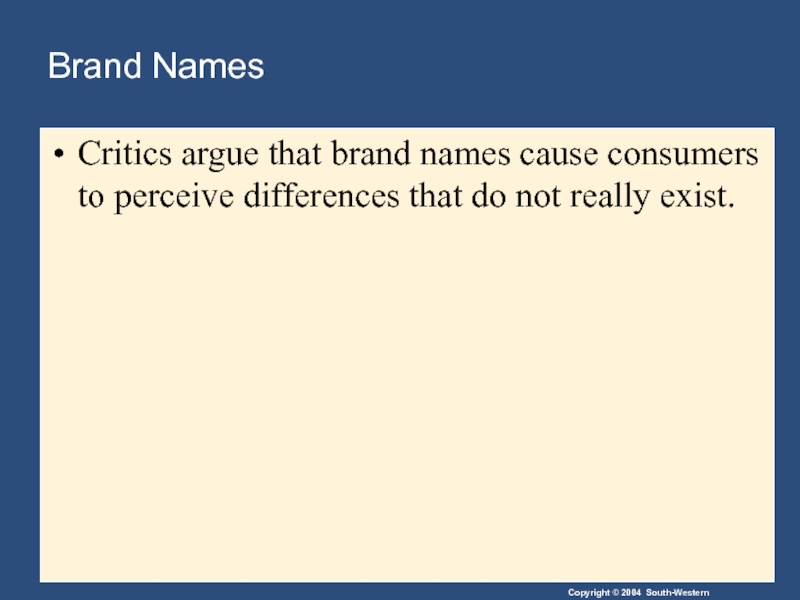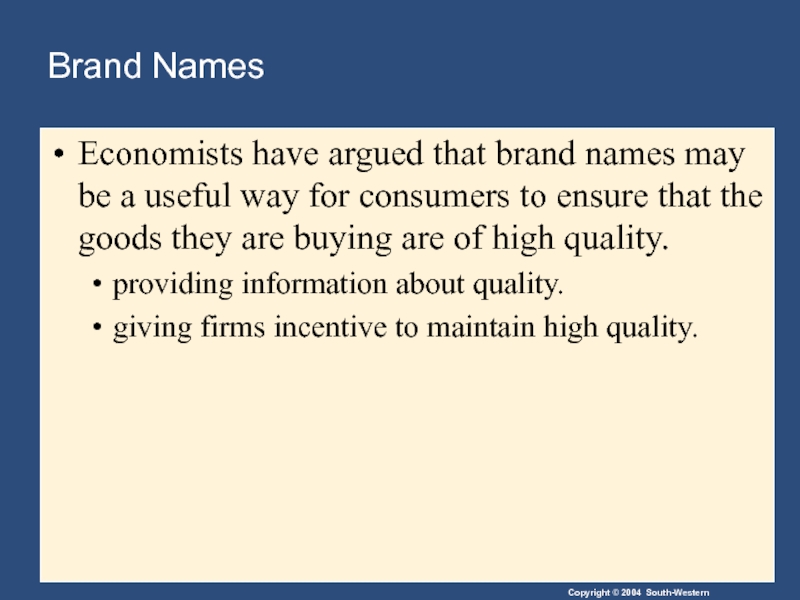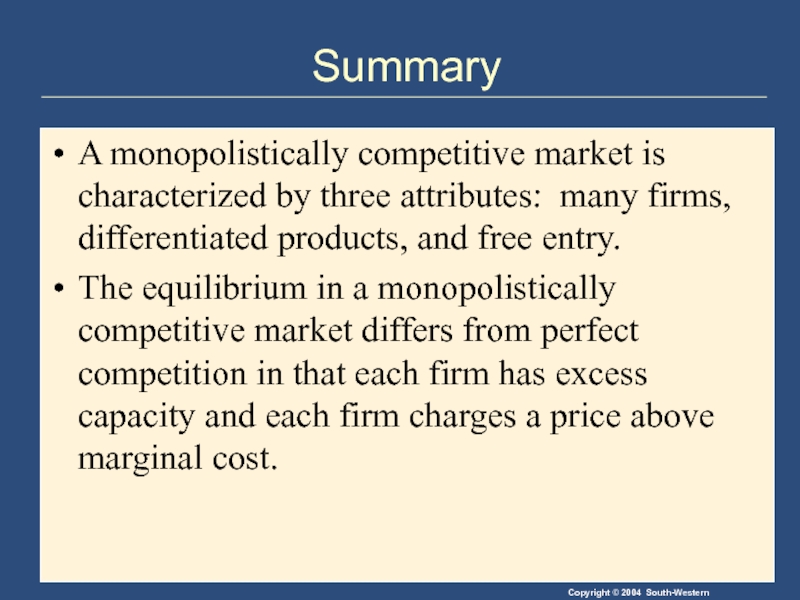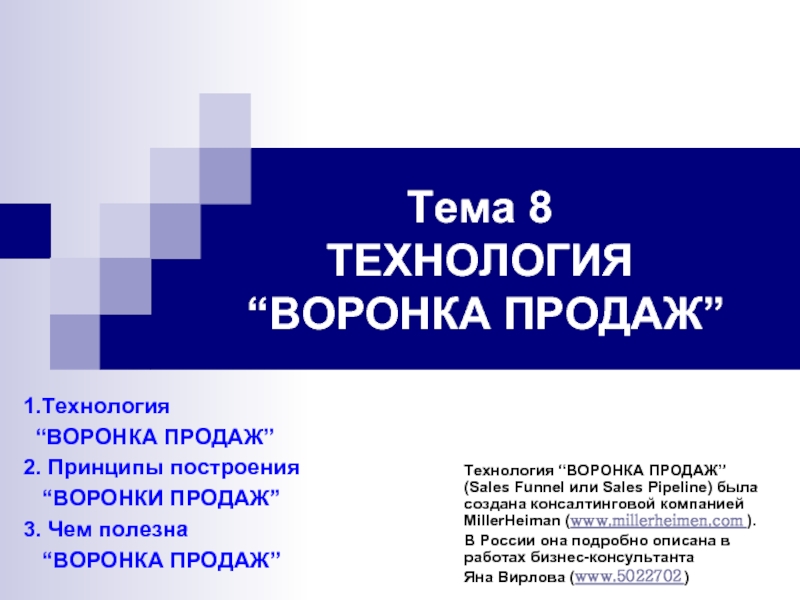- Главная
- Разное
- Дизайн
- Бизнес и предпринимательство
- Аналитика
- Образование
- Развлечения
- Красота и здоровье
- Финансы
- Государство
- Путешествия
- Спорт
- Недвижимость
- Армия
- Графика
- Культурология
- Еда и кулинария
- Лингвистика
- Английский язык
- Астрономия
- Алгебра
- Биология
- География
- Детские презентации
- Информатика
- История
- Литература
- Маркетинг
- Математика
- Медицина
- Менеджмент
- Музыка
- МХК
- Немецкий язык
- ОБЖ
- Обществознание
- Окружающий мир
- Педагогика
- Русский язык
- Технология
- Физика
- Философия
- Химия
- Шаблоны, картинки для презентаций
- Экология
- Экономика
- Юриспруденция
Monopolistic competition. (Lecture 17) презентация
Содержание
- 1. Monopolistic competition. (Lecture 17)
- 2. Monopolistic Competition Imperfect competition refers to those
- 3. The Four Types of Market Structure Copyright
- 4. Monopolistic Competition Types of Imperfectly Competitive Markets
- 5. Monopolistic Competition Markets that have some features of competition and some features of monopoly.
- 6. Monopolistic Competition Attributes of Monopolistic Competition Many sellers Product differentiation Free entry and exit
- 7. Monopolistic Competition Many Sellers There are
- 8. Monopolistic Competition Product Differentiation Each firm
- 9. Monopolistic Competition Free Entry or Exit
- 10. COMPETITION WITH DIFFERENTIATED PRODUCTS The Monopolistically Competitive
- 11. Figure 1 Monopolistic Competition in the Short
- 12. COMPETITION WITH DIFFERENTIATED PRODUCTS The Monopolistically Competitive
- 13. Figure 1 Monopolistic Competitors in the Short
- 14. The Long-Run Equilibrium Firms will enter and
- 15. Figure 2 A Monopolistic Competitor in the
- 16. Long-Run Equilibrium Two Characteristics As in
- 17. Monopolistic versus Perfect Competition There are two
- 18. Monopolistic versus Perfect Competition Excess Capacity There
- 19. Figure 3 Monopolistic versus Perfect Competition Copyright©2003
- 20. Monopolistic versus Perfect Competition Markup Over Marginal
- 21. Figure 3 Monopolistic versus Perfect Competition Copyright©2003
- 22. Figure 3 Monopolistic versus Perfect Competition Copyright©2003
- 23. Monopolistic Competition and the Welfare of
- 24. Monopolistic Competition and the Welfare of
- 25. Monopolistic Competition and the Welfare of
- 26. Monopolistic Competition and the Welfare of
- 27. Monopolistic Competition and the Welfare of
- 28. ADVERTISING When firms sell differentiated products and
- 29. ADVERTISING Firms that sell highly differentiated consumer
- 30. ADVERTISING Critics of advertising argue that firms
- 31. ADVERTISING Defenders argue that advertising provides information
- 32. Brand Names Critics argue that brand names
- 33. Brand Names Economists have argued that brand
- 34. Summary A monopolistically competitive market is characterized
- 35. Summary Monopolistic competition does not have all
- 36. Summary The product differentiation inherent in monopolistic
Слайд 2Monopolistic Competition
Imperfect competition refers to those market structures that fall between
perfect competition and pure monopoly.
Слайд 4Monopolistic Competition
Types of Imperfectly Competitive Markets
Monopolistic Competition
Many firms selling products that
are similar but not identical.
Oligopoly
Only a few sellers, each offering a similar or identical product to the others.
Oligopoly
Only a few sellers, each offering a similar or identical product to the others.
Слайд 5Monopolistic Competition
Markets that have some features of competition and some features
of monopoly.
Слайд 6Monopolistic Competition
Attributes of Monopolistic Competition
Many sellers
Product differentiation
Free entry and exit
Слайд 7Monopolistic Competition
Many Sellers
There are many firms competing for the same
group of customers.
Product examples include books, CDs, movies, computer games, restaurants, piano lessons, cookies, furniture, etc.
Product examples include books, CDs, movies, computer games, restaurants, piano lessons, cookies, furniture, etc.
Слайд 8Monopolistic Competition
Product Differentiation
Each firm produces a product that is at
least slightly different from those of other firms.
Rather than being a price taker, each firm faces a downward-sloping demand curve.
Rather than being a price taker, each firm faces a downward-sloping demand curve.
Слайд 9Monopolistic Competition
Free Entry or Exit
Firms can enter or exit the
market without restriction.
The number of firms in the market adjusts until economic profits are zero.
The number of firms in the market adjusts until economic profits are zero.
Слайд 10COMPETITION WITH DIFFERENTIATED PRODUCTS
The Monopolistically Competitive Firm in the Short Run
Short-run economic profits encourage new firms to enter the market. This:
Increases the number of products offered.
Reduces demand faced by firms already in the market.
Incumbent firms’ demand curves shift to the left.
Demand for the incumbent firms’ products fall, and their profits decline.
Слайд 11Figure 1 Monopolistic Competition in the Short Run
Copyright©2003 Southwestern/Thomson Learning
Quantity
0
Price
(a) Firm
Makes Profit
Слайд 12COMPETITION WITH DIFFERENTIATED PRODUCTS
The Monopolistically Competitive Firm in the Short Run
Short-run economic losses encourage firms to exit the market. This:
Decreases the number of products offered.
Increases demand faced by the remaining firms.
Shifts the remaining firms’ demand curves to the right.
Increases the remaining firms’ profits.
Слайд 13Figure 1 Monopolistic Competitors in the Short Run
Copyright©2003 Southwestern/Thomson Learning
Quantity
0
Price
(b) Firm
Makes Losses
Слайд 14The Long-Run Equilibrium
Firms will enter and exit until the firms are
making exactly zero economic profits.
Слайд 15Figure 2 A Monopolistic Competitor in the Long Run
Copyright©2003 Southwestern/Thomson Learning
Quantity
Price
0
Слайд 16Long-Run Equilibrium
Two Characteristics
As in a monopoly, price exceeds marginal cost.
Profit
maximization requires marginal revenue to equal marginal cost.
The downward-sloping demand curve makes marginal revenue less than price.
As in a competitive market, price equals average total cost.
Free entry and exit drive economic profit to zero.
The downward-sloping demand curve makes marginal revenue less than price.
As in a competitive market, price equals average total cost.
Free entry and exit drive economic profit to zero.
Слайд 17Monopolistic versus Perfect Competition
There are two noteworthy differences between monopolistic and
perfect competition—excess capacity and markup.
Слайд 18Monopolistic versus Perfect Competition
Excess Capacity
There is no excess capacity in perfect
competition in the long run.
Free entry results in competitive firms producing at the point where average total cost is minimized, which is the efficient scale of the firm.
There is excess capacity in monopolistic competition in the long run.
In monopolistic competition, output is less than the efficient scale of perfect competition.
Free entry results in competitive firms producing at the point where average total cost is minimized, which is the efficient scale of the firm.
There is excess capacity in monopolistic competition in the long run.
In monopolistic competition, output is less than the efficient scale of perfect competition.
Слайд 19Figure 3 Monopolistic versus Perfect Competition
Copyright©2003 Southwestern/Thomson Learning
Quantity
0
Price
(a) Monopolistically Competitive Firm
Quantity
0
Price
(b)
Perfectly Competitive Firm
Слайд 20Monopolistic versus Perfect Competition
Markup Over Marginal Cost
For a competitive firm, price
equals marginal cost.
For a monopolistically competitive firm, price exceeds marginal cost.
Because price exceeds marginal cost, an extra unit sold at the posted price means more profit for the monopolistically competitive firm.
For a monopolistically competitive firm, price exceeds marginal cost.
Because price exceeds marginal cost, an extra unit sold at the posted price means more profit for the monopolistically competitive firm.
Слайд 21Figure 3 Monopolistic versus Perfect Competition
Copyright©2003 Southwestern/Thomson Learning
Quantity
0
Price
(a) Monopolistically Competitive Firm
Quantity
0
Price
(b)
Perfectly Competitive Firm
Слайд 22Figure 3 Monopolistic versus Perfect Competition
Copyright©2003 Southwestern/Thomson Learning
Quantity
0
Price
(a) Monopolistically Competitive Firm
Quantity
0
Price
(b)
Perfectly Competitive Firm
Слайд 23Monopolistic Competition
and the Welfare of Society
Monopolistic competition does not have
all the desirable properties of perfect competition.
Слайд 24Monopolistic Competition
and the Welfare of Society
There is the normal deadweight
loss of monopoly pricing in monopolistic competition caused by the markup of price over marginal cost.
However, the administrative burden of regulating the pricing of all firms that produce differentiated products would be overwhelming.
However, the administrative burden of regulating the pricing of all firms that produce differentiated products would be overwhelming.
Слайд 25Monopolistic Competition
and the Welfare of Society
Another way in which monopolistic
competition may be socially inefficient is that the number of firms in the market may not be the “ideal” one. There may be too much or too little entry.
Слайд 26Monopolistic Competition
and the Welfare of Society
Externalities of entry include:
product-variety
externalities.
business-stealing externalities.
business-stealing externalities.
Слайд 27Monopolistic Competition
and the Welfare of Society
The product-variety externality:
Because consumers
get some consumer surplus from the introduction of a new product, entry of a new firm conveys a positive externality on consumers.
The business-stealing externality:
Because other firms lose customers and profits from the entry of a new competitor, entry of a new firm imposes a negative externality on existing firms.
The business-stealing externality:
Because other firms lose customers and profits from the entry of a new competitor, entry of a new firm imposes a negative externality on existing firms.
Слайд 28ADVERTISING
When firms sell differentiated products and charge prices above marginal cost,
each firm has an incentive to advertise in order to attract more buyers to its particular product.
Слайд 29ADVERTISING
Firms that sell highly differentiated consumer goods typically spend between 10
and 20 percent of revenue on advertising.
Overall, about 2 percent of total revenue, or over $200 billion a year, is spent on advertising.
Overall, about 2 percent of total revenue, or over $200 billion a year, is spent on advertising.
Слайд 30ADVERTISING
Critics of advertising argue that firms advertise in order to manipulate
people’s tastes.
They also argue that it impedes competition by implying that products are more different than they truly are.
They also argue that it impedes competition by implying that products are more different than they truly are.
Слайд 31ADVERTISING
Defenders argue that advertising provides information to consumers
They also argue that
advertising increases competition by offering a greater variety of products and prices.
The willingness of a firm to spend advertising dollars can be a signal to consumers about the quality of the product being offered.
The willingness of a firm to spend advertising dollars can be a signal to consumers about the quality of the product being offered.
Слайд 32Brand Names
Critics argue that brand names cause consumers to perceive differences
that do not really exist.
Слайд 33Brand Names
Economists have argued that brand names may be a useful
way for consumers to ensure that the goods they are buying are of high quality.
providing information about quality.
giving firms incentive to maintain high quality.
providing information about quality.
giving firms incentive to maintain high quality.
Слайд 34Summary
A monopolistically competitive market is characterized by three attributes: many firms,
differentiated products, and free entry.
The equilibrium in a monopolistically competitive market differs from perfect competition in that each firm has excess capacity and each firm charges a price above marginal cost.
The equilibrium in a monopolistically competitive market differs from perfect competition in that each firm has excess capacity and each firm charges a price above marginal cost.
Слайд 35Summary
Monopolistic competition does not have all of the desirable properties of
perfect competition.
There is a standard deadweight loss of monopoly caused by the markup of price over marginal cost.
The number of firms can be too large or too small.
There is a standard deadweight loss of monopoly caused by the markup of price over marginal cost.
The number of firms can be too large or too small.
Слайд 36Summary
The product differentiation inherent in monopolistic competition leads to the use
of advertising and brand names.
Critics argue that firms use advertising and brand names to take advantage of consumer irrationality and to reduce competition.
Defenders argue that firms use advertising and brand names to inform consumers and to compete more vigorously on price and product quality.
Critics argue that firms use advertising and brand names to take advantage of consumer irrationality and to reduce competition.
Defenders argue that firms use advertising and brand names to inform consumers and to compete more vigorously on price and product quality.
